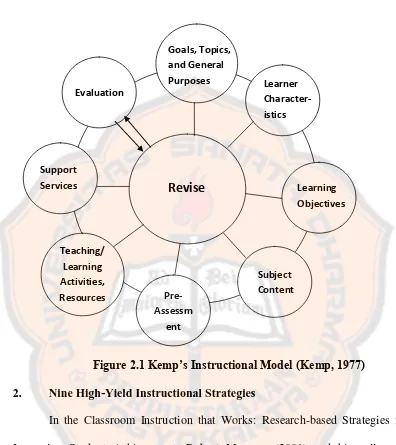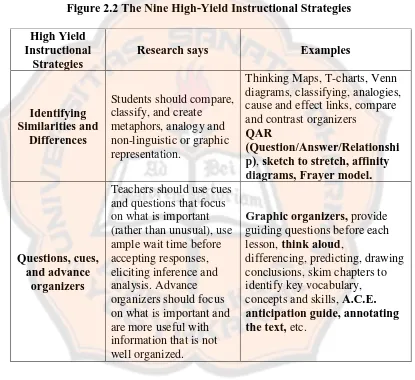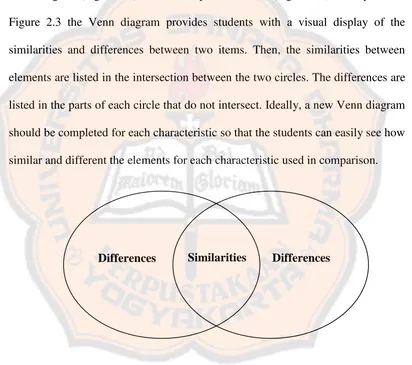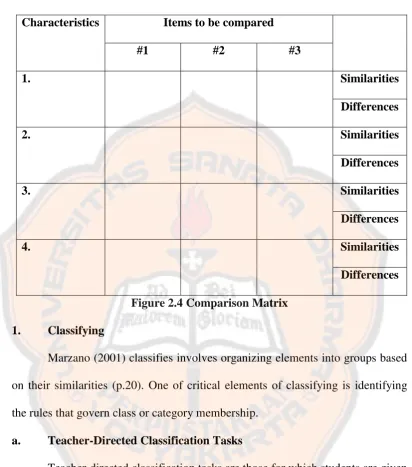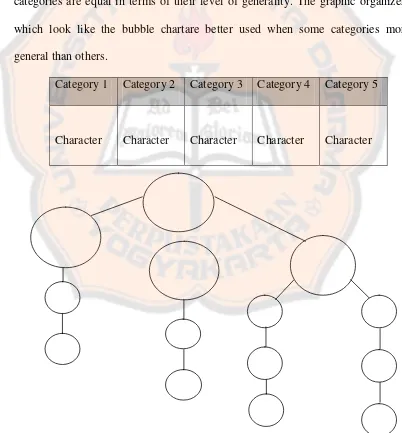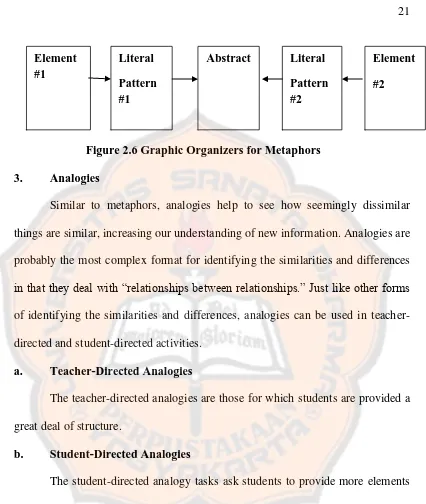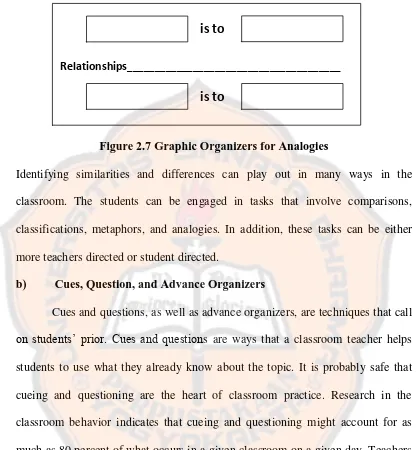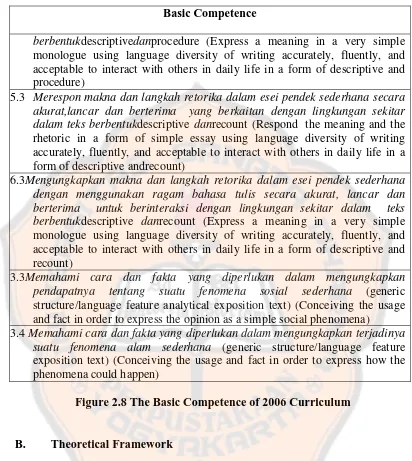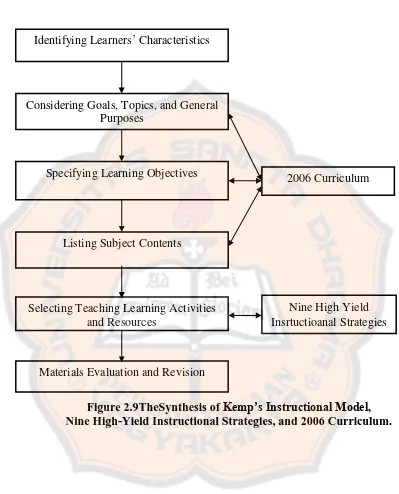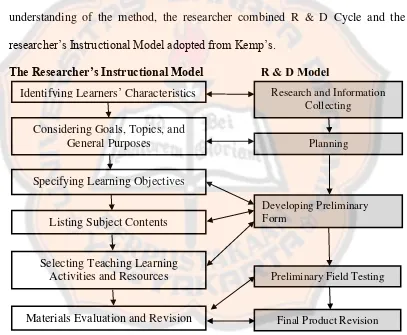ABSTRACT
Rahayu, Tita. (2014). Designing A Set of English Materials Using Nine High-Yield Instructional Strategies for Grade IX SMP Taman Dewasa IP Yogyakarta.Yogyakarta: English Language Education Study Program, Sanata Dharma University.
This research is conducted to develop a set of English materials that focuses on grade IX students’ English language skills. The English materials apply Nine High-Yield Instructional Strategies as the learning method. This research employs “Identifying Similarities and Differences” and “Cues, Question, and Advance Organizer.” Identifying Similarities and Differences mean that the students should compare, classify, and create metaphors, analogy and non-linguistic or graphic representation. Whereas, Cues, Question, and Advance Organizer mean that teachers should use cues and questions that focus on what are important, use ample wait timebefore accepting responses, eliciting inference and analysis. Advance organizers should focus on what is important and are more useful with information that is not well organized.
There are two research problems addressed on this research. The first is to know how a set of English materials using Nine High-Yield Instructional Strategies for Grade IX of SMP Taman Dewasa Ibu Pawiyatan Yogyakarta is designed. The second is to know what the designed set of English materials for grade IX of SMP Taman Dewasa Ibu Pawiyatan Yogyakarta looks like. In this research, the researcher applies five steps of Research and Development (R & D) as the research method.
To answer the first research problem, the researcher applies six steps of the instructional design model, which are adapted from Kemp’s model. Those steps are (1) identifying learners’ characteristics, (2) considering goals, topics, and general purposes, (3) specifying learning objectives, (4) listing subject contents, (5) selecting teaching learning activities and resources, and (6) materials evaluation and revision. In order to answer the second research problem, the researcher presents the English materials for grade IX which consisted of four units. Each unit consists of three sections, namely pre-activities, main-activities, and post-activities. The activities in the designed materials aim to improve students’ ability in applying English language skill and social skill in daily life.
The researcher obtains the evaluation from the respondents regarding the designed materials. The results of materials evaluation show that almost all opinion ranged between point four and point five in the degree of agreement. It showed that the designed materials are good and appropriate to be implemented in Grade IX of SMP Taman Dewasa Ibu Pawiyatan Yogyakarta.
ABSTRAK
Rahayu, Tita. (2014). Designing A Set of English Materials Using Nine High-Yield Instructional Strategies for Grade IX SMP Taman Dewasa IP Yogyakarta. Yogyakarta: Program Studi Pendidikan Bahasa Inggris, Universitas Sanata Dharma.
Penelitian ini dilakukan untuk mengembangkan materi pembelajaran yang mengacu pada kemampuan berbahasa Inggris siswa kelas IX. Materi ini menerapkan Nine High-Yield Instructional Strategies sebagai metode belajar siswa. Penelitian ini menggunakan Identifying Similarities and Differences dan
Cues, Question, and Advance Organizer. Identifying Similarities and Differences
berarti siswa sebaiknya membandingkan, mengklasifikasikan, dan membuat kiasan, analogi dan non-linguistic atau gambar. Sedangkan Cues, Question, and Advance Organizers, guru sebaiknya menggunakan isyarat dan pertanyaan yang mengacu pada hal penting, menggunakan waktu yang cukup sebelum menanggapi suatu hal, dengan menarik kesimpulan dan analisa. Advance organizers mengacu pada hal penting dan sesuatu yang berguna dengan informasi yang tidak berurutan.
Terdapat dua rumusan masalah dalam penelitian ini. Rumusan yang pertama adalah untuk mengetahui bagaimana satu set materi pembelajaran Bahasa Inggris untuk siswa kelas IX menggunakan Nine High-Yield Intructional Strategies di SMP Taman Dewasa Ibu Pawiyatan Yogyakarta dirancang. Rumusan yang kedua adalah untuk mengetahui seperti apakah penyajian satu set materi pembelajaran untuk siswa kelas IX menggunakan Nine High Yield Intructional Strategies di SMP Taman Dewasa Ibu Pawiyatan Yogyakarta.Dalam penelitian ini, peneliti menggunakan lima tahap Research and Development
sebagai metode penelitian..
Untuk menjawab rumusan masalah pertama, peneliti menerapkan enam langkah instructional design model yang telah diadaptasi dari milik Kemp. Langkah tersebut adalah (1) identifying learners’ characteristics, (2) considering goals, topics, and general purposes, (3) specifying learning objectives, (4) listingsubject contents, (5) selecting teaching learning activities and resources,
dan (6) materials evaluation and revision. Untuk menjawab permasalahan yang kedua, peneliti memperkenalkan materi pembelajaran Bahasa Inggris untuk kelas IX yang terdiri dari 4 unit. Setiap unit terdiri dari 3 bagian yaitu pre-activities, main-activities, dan post-activities Segala aktivitas yang ada di dalam materi pembelajaran ini bertujuan untuk meningkatkan kemampuan siswa untuk mengaplikasikan penggunaan Bahasa Inggris serta meningkatkan kemampuan sosial siswa di dalam kehidupan sehari-hari.
Pada akhir penelitian, peneliti mendapatkan evaluasi dari responden mengenai materi pembelajaran. Hasil dari evaluasi tersebut menunjukkan hampir semua pendapat responden berkisar diantara poin empat dan poin lima dalam tingkat kesepakatan. Hal ini menunjukan bahwa materi yang dirancang baik dan tepat untuk diterapkan di kelas IX SMP Taman Dewasa IP Yogyakarta.
i
DESIGNING A SET OF ENGLISH MATERIALS
USING NINE HIGH-YIELD INSTRUCTIONAL STRATEGIES
FOR GRADE IX SMP TAMAN DEWASA IP YOGYAKARTA
A SARJANA PENDIDIKAN THESIS
Presented as Partial Fulfillment of the Requirements to Obtain the Sarjana Pendidikan Degree
in English Language Education
By Tita Rahayu
Student Number: 101214162
ENGLISH LANGUAGE EDUCATION STUDY PROGRAM DEPARTMENT OF LANGUAGE AND ARTS EDUCATION FACULTY OF TEACHERS TRAINING AND EDUCATION
SANATA DHARMA UNIVERSITY YOGYAKARTA
vi ABSTRACT
Rahayu, Tita. (2014). Designing A Set of English Materials Using Nine High-Yield Instructional Strategies for Grade IX SMP Taman Dewasa IP Yogyakarta.Yogyakarta: English Language Education Study Program, Sanata Dharma University.
This research is conducted to develop a set of English materials that focuses on grade IX students’ English language skills. The English materials apply Nine High-Yield Instructional Strategies as the learning method. This
research employs “Identifying Similarities and Differences” and “Cues, Question, and Advance Organizer.” Identifying Similarities and Differences mean that the students should compare, classify, and create metaphors, analogy and non-linguistic or graphic representation. Whereas, Cues, Question, and Advance Organizer mean that teachers should use cues and questions that focus on what are important, use ample wait timebefore accepting responses, eliciting inference and analysis. Advance organizers should focus on what is important and are more useful with information that is not well organized.
There are two research problems addressed on this research. The first is to know how a set of English materials using Nine High-Yield Instructional Strategies for Grade IX of SMP Taman Dewasa Ibu Pawiyatan Yogyakarta is designed. The second is to know what the designed set of English materials for grade IX of SMP Taman Dewasa Ibu Pawiyatan Yogyakarta looks like. In this research, the researcher applies five steps of Research and Development (R & D) as the research method.
To answer the first research problem, the researcher applies six steps of
the instructional design model, which are adapted from Kemp’s model. Those steps are (1) identifying learners’ characteristics, (2) considering goals, topics, and
general purposes, (3) specifying learning objectives, (4) listing subject contents, (5) selecting teaching learning activities and resources, and (6) materials evaluation and revision. In order to answer the second research problem, the researcher presents the English materials for grade IX which consisted of four units. Each unit consists of three sections, namely pre-activities, main-activities, and post-activities. The activities in the designed materials aim to improve
students’ ability in applying English language skill and social skill in daily life.
The researcher obtains the evaluation from the respondents regarding the designed materials. The results of materials evaluation show that almost all opinion ranged between point four and point five in the degree of agreement. It showed that the designed materials are good and appropriate to be implemented in Grade IX of SMP Taman Dewasa Ibu Pawiyatan Yogyakarta.
vii ABSTRAK
Rahayu, Tita. (2014). DesigningA Set of English Materials Using Nine High-Yield Instructional Strategies for Grade IX SMP Taman Dewasa IP Yogyakarta. Yogyakarta: Program Studi Pendidikan Bahasa Inggris, Universitas Sanata Dharma.
Penelitian ini dilakukan untuk mengembangkan materi pembelajaran yang mengacu pada kemampuan berbahasa Inggris siswa kelas IX. Materi ini menerapkan Nine High-Yield Instructional Strategies sebagai metode belajar siswa. Penelitian ini menggunakan Identifying Similarities and Differences dan
Cues, Question, and Advance Organizer. Identifying Similarities and Differences
berarti siswa sebaiknya membandingkan, mengklasifikasikan, dan membuat kiasan, analogi dan non-linguistic atau gambar. Sedangkan Cues, Question, and Advance Organizers, guru sebaiknya menggunakan isyarat dan pertanyaan yang mengacu pada hal penting, menggunakan waktu yang cukup sebelum menanggapi suatu hal, dengan menarik kesimpulan dan analisa. Advance organizers mengacu pada hal penting dan sesuatu yang berguna dengan informasi yang tidak berurutan.
Terdapat dua rumusan masalah dalam penelitian ini. Rumusan yang pertama adalah untuk mengetahui bagaimana satu set materi pembelajaran Bahasa Inggris untuk siswa kelas IX menggunakan Nine High-Yield Intructional Strategies di SMP Taman Dewasa Ibu Pawiyatan Yogyakarta dirancang. Rumusan yang kedua adalah untuk mengetahui seperti apakah penyajian satu set materi pembelajaran untuk siswa kelas IX menggunakan Nine High Yield Intructional Strategies di SMP Taman Dewasa Ibu Pawiyatan Yogyakarta.Dalam penelitian ini, peneliti menggunakan lima tahap Research and Development
sebagai metode penelitian..
Untuk menjawab rumusan masalah pertama, peneliti menerapkan enam langkah instructional design model yang telah diadaptasi dari milik Kemp. Langkah tersebut adalah (1) identifying learners’ characteristics, (2) considering goals, topics, and general purposes, (3) specifying learning objectives, (4) listingsubject contents, (5) selecting teaching learning activities and resources,
dan (6) materials evaluation and revision. Untuk menjawab permasalahan yang kedua, peneliti memperkenalkan materi pembelajaran Bahasa Inggris untuk kelas IX yang terdiri dari 4 unit. Setiap unit terdiri dari 3 bagian yaitu pre-activities, main-activities, dan post-activities Segala aktivitas yang ada di dalam materi pembelajaran ini bertujuan untuk meningkatkan kemampuan siswa untuk mengaplikasikan penggunaan Bahasa Inggris serta meningkatkan kemampuan sosial siswa di dalam kehidupan sehari-hari.
Pada akhir penelitian, peneliti mendapatkan evaluasi dari responden mengenai materi pembelajaran. Hasil dari evaluasi tersebut menunjukkan hampir semua pendapat responden berkisar diantara poin empat dan poin lima dalam tingkat kesepakatan. Hal ini menunjukan bahwa materi yang dirancang baik dan tepat untuk diterapkan di kelas IX SMP Taman Dewasa IP Yogyakarta.
viii
ACKNOWLEDGEMENTS
First of all I would like to send my greatest gratitude and praise to the One and only, Jesus Christ for His blessing and strength given to me to fix this thesis. He is the one who makes me believe that I can do better than what I have expected. He is the miracle in my life that makes me survive in every challenge on my face. He is the one who never leaves me.
My greatest gratitude and deep appreciation belongs to my caring thesis supervisor Markus Budiraharjo, S.Pd., M.Ed., Ed.D. for his invaluable guidance, support, time, advice, and patience during this challenging process of working this thesis. I also express my honor to the lecturers of English Language Education Study Program, especially Drs. Barli Bram, M.Ed., Ph.D., and Miss Ch. Lhaksmita Anandari, S.Pd., Ed.M., for evaluating and giving beneficial suggestion upon my designed materials. Then, I give my gratitude for the lecturer of the Sampoerna University, Miss Adesti Komalasari, S.Pd., M.A., for evaluating and giving me suggestion of the designed materials. My sincere gratitute is sent to Budi Angkoso, S.Pd., the headmaster of SMP Taman Dewasa Ibu Pawiyatan Yogyakarta, who given the oppurtunity to conduct the research and also for Bu Feni Astuti, S.Pd. for the evaluation of my research and then Bu Any Qri Handayani, S.Pd., as an English teacher of Grade IX.
ix
My gratitude also belongs to my basketball friends as my second family in Yogyakarta. They are Theresa Agnes Boki, Jojo, NandaHutagaol, Veronica Tyas,Martha, Vita, Veny, Lidya, Purwati, Yoren, Thongka, Rara, Ayumi,Maleh, Boni, George, Andrian, Nehem, Edy, Aven, Ardi, Intan, Ruth, Adip, Albert, Yansen, Momo, Anthon, Mas Rinto (coach), Ko Owen (ex coach), and Mas Adhi (ex coach), for spending time together playing basketball and supporting me in doing my thesis.
I would like to express my great appreciation to my classmates:Emmanualla Venni, Theresia Vernalita, Friska Dita, IndyMagong , Ria Ongabelle, Monica Surya, Stevanie Melinda, Maria Agnes, Deliana, Bayu Pamungkas, Yosafat Anggun, Mei Nadia, Pandhu Mahendra, Cindy, Helena, Mentari,and all of my friends in the English Language Education Study Program for supportingme in the thesis writing process.
I would like to express my gratitude to my friends who also support me in doing my thesis: Theresia Heny Freny, Yohanes Yojana Jati, Gregorius Rudi, Adi Rooswanto, and Mas Dedi. I thank to my hometown friends: Jivana, Yuvita, Julius, Febri, Kasidi, Aweng, Mas Beni, Tesa, Dwi, Apri, and Kiky, for supporting and motivating me through the thesis process.
I would like to extend my thanks toall lecturers of the English Language Education Study Program and also MbakDanik, and Mbak Tari for giving me information.
x
TABLE OF CONTENTS
Page
TITLE PAGE ... i
APPROVAL PAGE ... ii
STATEMENT OF WORK’S ORIGINALITY ... iv
PERNYATAAN PERSETUJUAN PUBLIKASI ... v
ABSTRACT ... vi
ABSTRAK ... vii
ACKNOWLEDGEMENTS ... viii
TABLE OF CONTENTS ... x
LIST OF TABLES ... xiii
LIST OF FIGURES ... xiv
LIST OF APPENDICES ... xv
CHAPTER I. INTRODUCTION A. Research Background ... 1
B. Research Problems ... 3
C. Problem Limitation ... 3
D. Research Objectives ... 4
E. Research Benefits ... 4
F. Definition of Terms ... 5
1. Nine High-Yield Instructional Strategies ... 5
2. Instructional Materials ... 5
3. Grade IX SMPTaman Dewasa Ibu Pawiyatan Yogyakarta ... 6
4. 2006 Curriculum ... 6
CHAPTER II. REVIEW OF RELATED LITERATURE A. Theoritical Description ... 7
1. Kemp’s Instructional Design ... 7
2. Nine High-Yield Instructional Strategies ... 12
a. Similarities and Differences ... 13
b. Cues, Questions and Advance Organizers ... 22
xi
B. Theoritical Framework ... 27
CHAPTER III. RESEARCH METHODOLOGY A. Research Method ... 29
1. Research and Information Collecting ... 31
2. Planning ... 32
3. Developing Preliminary Form of Product ... 32
4. Preliminary Field Testing ... 32
5. Main Product Revision ... 33
B. Research Setting ... 33
C. Research Participants ... 34
1. Participants of the Research and Information Collecting Stage ... 34
2. Participants of the Preliminary Field Testing Stage ... 34
D. Research Instrument and Data Gathering Techniques ... 36
1. Questionaire ... 36
2. Interview ... 38
E. Data Analysis Techniques ... 38
F. Research Procedure ... 41
CHAPTER IV. RESEARCH RESULTS AND DISCUSSION A. The Design Process ... 43
1. Identifying Learners’ Characteristics ... 43
a. Student Needs Based on the Interview and Field Observation ... 44
b. Student Needs Based on Questionnaire ... 45
2. Considering Goals Topics and General Purposes ... 50
3. Specifying Learning Objectives ... 53
4. Listing Subject Content ... 56
5. Selecting Teaching Learning Activities and Resources ... 56
B. Results and Discussions on the Evaluation ... 57
1. Material Evaluation and Revision ... 57
a. Description of the Respondents ... 58
xii
c. Description on the Revision ... 65
C. Presentation of the Designed Materials ... 65
CHAPTER V. CONCLUSIONS AND RECOMMENDATIONS A. Conclusions ... 69
B. Recommendations ... 71
1. For English Teachers ... 72
2. For Future Researchers ... 72
REFERENCES ... 73
xiii
LIST OF TABLES
Table Page
3.1 The Description of the Respondents ofMaterials Evaluation (blank) ... 35
3.2 The Format of Respondents’ Opinion Questionnaire of Materials Evaluation ... 40
4.1 The Result of Questionnaire on Need Survey ... 45
4.2 The Units and the Topics in the Designed Material... 51
4.3 The General Purposes for the Designed Material ... 52
4.4 The Indicators for the Designed Material ... 53
4.5 The Description of the Respondents of Material Evaluation ... 58
4.6 Degree of Agreement ... 59
4.7 The Result of Respondents’ Opinion Questionnaire of MaterialEvaluation ... .60
xiv
LIST OF FIGURES
Figure Page
2.1 Kemp’s Instructional Model (Kemp, 1977) ... 12
2.2 Marzano’s High-Yield Instructional Strategies ... 13
2.3 Venn Diagram ... 17
2.4 Comparison Matrix ... 18
2.5 Graphic Organizers for Classification ... 19
2.6 Graphic Organizer for Metaphors ... 21
2.7 Graphic Organizer for Analogies ... 22
2.8 The Basic Competence of 2006 Curriculum ... 26
2.9 The Synthesis of Kemp’s Instructional Model, Nine High-Yield Instructional Strategies, and 2006 Curriculum ... 29
xv
LIST OF APPENDICES
Appendix Page
Appendix A: Research Permit Statement (ELESP Secretariat) ... 76
Appendix B : Questionnaire on the Needs Survey ... 78
Appendix C : Questionnaire on Material Evaluation ... 81
Appendix D : Lesson Plans ... 86
1 CHAPTER I INTRODUCTION
This chapter consists of the research background, research problem, problem limitation, research objectives, research benefits, and definition of terms. The research background provides information on the topic of this research and reasons for choosing the topic. The research problem section formulates questions to make this research more directed. The problem limitation limits the scope of the research. The research objectives tell the purpose of the research. The benefits of the research present who can obtain the benefits from this research. The last part is the terms related to the research defined.
A. Research Background
Every Junior High School has English as one of the subjects that the students have to achieve English mastery. English is one important subject in Junior High School. It is essential for students to build their willingness in learning English. English is a course that used in final examination beside Indonesian Language, Mathematics, and Science. Therefore, the English teachers are responsible to make the students achieve the best result in English course.
SMP Taman Dewasa Ibu Pawiyatan Yogyakarta is a part of Taman Siswa Institution in Yogyakarta. It is located at Taman Siswa Street 25 Wirogunan, Mergangsan, Yogyakarta 5515. Historically, SMP Taman Dewasa Ibu Pawiyatan
Ibu Pawiyatan Junior High School becomes Pilot Project (model schools) for Taman Siswa Junior High School throughout Indonesia. However, SMP Taman Dewasa Ibu Pawiyatan Yogyakarta has an A accreditation. This school also has many non-academic activities to develop psychomotor skill such as pencak silat, scouts, traditional dance class, basketball, choir, and karawitan for students.
Therefore, the researcher focuses on grade IX students of SMP Taman Dewasa Ibu Pawiyatan Yogyakarta. Firstly, the students showed a low degree of interest in English. Secondly, the teachers tended to teach in a teacher-centered fashion. Third, the teachers were not skillful enough in developing materials. This
school had three English teachers. Based on some of the students’ experiences, the
vocational school because they are expected to work. The students are demanded to have a good English language skills, to achieve standard competence, and to prepare them to the next level. Then, the English teacher needs to draw the activities as interesting as possible so the students can enjoy the learning process. Therefore, the researcher concludes that the grade IX needs a set of English materials which can guide them to achieve the standard competence.
B. Research Problems
The researcher intends to answer two questions. Those two questions are:
1. How is a set of English materials using Nine High-Yield Strategies for grade IX of SMP Taman Dewasa Ibu Pawiyatan Yogyakarta designed?
2. What does the set of designed English materials for grade IX of SMP Taman Dewasa Ibu Pawiyatan Yogyakarta look like?
C. Problem Limitation
D. Research Objectives
The research intends to answer the research problems. Therefore, this research intends two objectives. The objectives of the research are as follows: 1. To find out how a set of English materials using Nine High-Yield Instructional Strategies for grade IX of SMP Taman Dewasa Ibu Pawiyatan Yogyakarta is designed.
2. To find out what the set of designed English materials for grade IX of
SMP Taman Dewasa Ibu Pawiyatan Yogyakarta looks like.
E. Research Benefits
The result of this research is beneficial related to teaching-learning process. Those who might get benefits are:
1. The English Teachers
The teachers may use the results of this research as an input to determine which technique is appropriate in the classroom activity and they can apply the English materials in the classroom.
2. The Students
The students will enjoy the following activities in learning English using the designed materials. The students can understand the English materials.
3. The Writer
This research gives benefits for the writer’s feedback and self-evaluation.
F. Definition of Terms
This part defines some specific terms related to the research. It has purposed to avoid different perception about some terms which are discussed in the research.
1. Nine High-Yield Instructional Strategies
The researcher considers Nine High-Yield Instructional Strategies as the
method for conducting the research. Marzano’sHigh-Yield Instructional Strategies
has nine strategies. In this research, the researcher only using two entitled Identifying Similarities and Differences and Cues, Questions, and Advance Organizers. Coleman and his colleagues concluded that the vast majority of the differences in the student achievement can be attributed two factors like the
student’s natural ability or aptitude, the socioeconomic status of the student, and
the student’s home environment.
2. Instructional Material
3. Grade IX SMP Taman Dewasa Ibu Pawiyatan Yogyakarta
Grade IX Taman SMP Taman Dewasa Ibu Pawiyatan Yogyakarta is the third level of junior high school in Yogyakarta namely Taman Dewasa Ibu Pawiyatan which consists of three classes from class IX A up to class IX C.
4. 2006 Curriculum
7 CHAPTER II
REVIEW OF RELATED LITERATURE
This chapter is divided into two parts. The first part is theoretical description that provides theories and definitions of related terms and the second part is theoretical framework that emphasizes the relation of the theories and this research.
A. Theoretical Description
This section discusses the theories of instructional design proposed by
R&D method, Kemp’s Instructional Design and Nine High-Yield Instructional
Strategies.
1. Kemp’s Instructional Design
In this research, the researcher applies Kemp’s design in developing the
English materials. Kemp’s method can be applied in any educational level and it
is an appropriate method for the researcher to develop the materials. Kemp offers instructional technology which means the systematic design of the instruction, based on the knowledge of the learning process and on communication theory hence that successful learning will result (Morrison, Ross, Kalman, & Kemp,
2011, p. 2). The researcher applied Kemp’s design because this is a flexible
Step 1. Defining Goals, Topics, and General Purposes
Kemp starts his instructional design planning with the recognition of the broad goals of the school system. Those broad goals may be derived from three sources; namely society, students, and subject areas. Kemp (1977) noted that statements of the goals should be flexible. It means the materials designers should
pay attention to the changes of the learners’ needs and interests, as well as
changes in society and institutions. After defining the goals, teachers have to select and list the major topics. The topics are usually sequenced based on a logical organization, most often from simple to complex levels or from concrete to abstract levels. The next responsibility of teachers is deciding to select one or more purposes to represent a topic. A single topic can serve more than one purposes.
Step 2. Recognizing Learner Characteristic
The important aspect of teaching-learning process are recognizing the
learners’ characteristics and respecting them as an individual learner. In order to
serve both individuals and groups, the teachers must obtain the information about
learners’ capabilities, needs, and interests. In finding out the learners’
factors include age, maturity, attention span, special talents, physical and emotional handicaps, relations among students, socioeconomic situation.
Step 3. Specifying Learning Objectives
Specifying learning objectives is essential. All objectives must be stated in terms of activities that will be best promoting learning. There are three major categories; namely cognitive, psychomotor, and affective. They are generally called domain. Cognitive domain is a domain that gives most attention to educational programs. Bloom in 1965 has developed taxonomy for the cognitive domain. However, since it is proposed in the mid-nineties, the researcher adapts
the revisited Bloom’s taxonomy by Lorin Anderson, a former student of Bloom.
Anderson et al. (2000) makes some changes, with the two most prominent ones being, changing the names in the six categories from noun to verb forms, and slightly rearranging them. The revisited Bloom’s taxonomy includes creating, evaluating, analyzing, applying, understanding, and remembering. Kemp
(1977) discovers that objectives are beneficial because they form the framework for any instructional program built on a competency base and inform the students what will be required for them. Objectives also help to think in specific terms, to organize, and to sequence the subject matter.
Step 4. Organizing Subject Content
Step 5. Developing Pre-Assessment
Developing pre-assessment is done after examining the learning objectives and the subject contents. There are two questions which should be taken as consideration; (1) is the students prepared to study the topic or unit? and (2) is the students already competent in some of the stated objectives? In answering these two questions, there are two kinds of tests namely prerequisite testing and pretesting. Prerequisite testing is conducted to determine whether the students have the appropriate background preparation for the topic. This test can be a
testing performance, reviewing student’s related or previous work, interviewing
the students, or observing the students. On the other hand, pretesting is conducted to determine which objectives that the students have already achieved. In pretesting, the researcher can use a pre-topic questionnaire or oral questioning to the class. The results of pre-assessment will affect the instructional planning. It may be necessary to eliminate, modify, or add objectives to the program.
Step 6. Planning the Teaching/Learning Activities and Resources
content. Selecting media as a supporting service is the step after selecting the instructional resources.
Step 7. Considering Support Services
This step, considering support services, includes funds, facilities, equipment, and personnel whose time must be scheduled for participation in the instructional plan. Financial support is divided into two parts; during development and during implementation of the program. The facilities for an instructional program needs the following activities; presentations to groups, independent study stations, small-group meeting rooms, a resource center, staff meeting rooms, and workrooms. The equipment that will be used must be reasonable in terms of what funds are available, the complexity of the equipment, and upkeep. Time allocation is the most difficult element to deal with any new program. Time allocation deals with schedule of staff orientation, training, and students.
Step 8. Evaluating Student’s Achievement
In this step, the teachers measure the learning outcomes relating to the objectives. To measure the students’ achievements, teachers should have standards of achievement. The evaluation can be through paper-and-pencil testing, checking performance, and psychomotor objectives, checking the affective domain, and testing with audiovisual or other materials. There are two phases in evaluation of learning. The first is formative evaluation. This evaluation takes place during development and tryouts. The second is summative evaluation,
Figure 2.1 Kemp’s Instructional Model (Kemp, 1977)
2. Nine High-Yield Instructional Strategies
In the Classroom Instruction that Works: Research-based Strategies for Increasing Student Achievement, Robert Marzano (2001) and his colleagues identify Nine High-Yield Instructional Strategies through a meta-analysis of over 100 independent studies. They determined that these nine strategies have the greatest positive effects on student achievement for all students, in all subject areas, at all grade levels.
In this research, the researcher applies two of the Nine High-Yield Instructional Strategies to develop English materials for grade IX SMP Taman
Evaluation
Goals, Topics, and General
Purposes Learner
Character-istics
Learning Objectives
Subject Content Pre-
Assessment Teaching/
Learning Activities, Resources Support
Services
Revise
Pre- Assessm
Dewasa Ibu Pawiyatan Yogyakarta, they are Identifying Similarities and Differences and Cues, Question, and Advance Organizer. Here are Marzano’s high-yield instructional strategies which used for this research are summarized in the table that follows.
Figure 2.2 The Nine High-Yield Instructional Strategies High Yield
Instructional Strategies
Research says Examples
Identifying Similarities and
Differences
Students should compare, classify, and create metaphors, analogy and non-linguistic or graphic representation.
Thinking Maps, T-charts, Venn diagrams, classifying, analogies, cause and effect links, compare and contrast organizers
QAR
(Question/Answer/Relationshi p), sketch to stretch, affinity diagrams, Frayer model.
Questions, cues, and advance
organizers
Teachers should use cues and questions that focus on what is important (rather than unusual), use ample wait timebefore accepting responses, eliciting inference and analysis. Advance organizers should focus on what is important and are more useful with information that is not well organized.
Graphic organizers, provide guiding questions before each lesson, think aloud,
differencing, predicting, drawing conclusions, skim chapters to identify key vocabulary, concepts and skills, A.C.E. anticipation guide, annotating the text, etc.
a. Similarities and Differences
1) Research and Theory on Identifying Similarities and Differences Marzano draws at least four salient generalizations from the research and theory in this area:
a) Presenting students with explicit guidance in identifying similarities
and differences enhances students’ understanding of and ability to use
knowledge. Probably the most straightforward way to help students identify similarities and differences between topics are to simply present these similarities and differences to them. In fact a great deal of research attests to the effectiveness of this rather direct approach. The presentation of similarities and differences are accompanied by a great deal of rich discussion and inquiry on the part of students. Therefore, the teacher gives the students some clues to guide them to achieve the goal of the study explicitly. Then students identify the similarities and differences by comparing two things or more.
b) Asking students to independently identify similarities and differences
enhances students’ understanding of and ability to use knowledge. It is a
strong research base supporting the effectiveness of having students identifies
similarities and differences without direct input from the teacher. Both “teacher
-directed” and “student-directed” activities focus on identifying similarities and
c) Representing similarities and differences in graphic or symbolic form
enhances students’ understanding of and ability to use knowledge. It is one of
more powerful findings within this general category of instructional strategy. The
experts use greatly enhances students’ ability to understand and generate
similarities and differences.
d) Identification of similarities and differences can be accomplished in a variety of ways. The identification of similarities and differences is highly robust activity. Research indicates that four different “form” of this activity are highly effective:
1. Comparing is the process of identifying similarities and differences between or among things or ideas.
2. Classifying is the process of grouping things that are alike into categories on the basis of their characteristics.
3. Creating metaphors are the process of identifying a general or basic pattern in a specific topic and then finding another topic that appears to be quite different but that has the same general pattern.
4. Creating analogies are the process of identifying relationships between
pair’s concepts in other words, identifying relationships between relationships.
identifying abstract similarities and differences between two elements. Finally, creating analogies involves identifying how to pairs of elements are similar and different. Marzano writes a note that technically, the term comparingrefers to the process of identifying similarities, and the term contrasting refers to the process of identifying differences. Most educators, however, use the term comparing to refer to both.
2) Classroom Practice in Identifying Similarities and Differences a) Comparing
According to Marzano (2001), the key to an effective comparison is the identification of the important characteristics (p.17). These characteristics are used as the basis for which similarities and differences are identified.
1. Teacher-Directed Comparison Tasks
Marzano states although the process of comparing might seem simple, it is not. He suggests that teachers introduce the process of comparing by presenting the students with highly structured tasks. It means that a teacher identifies for the students the items that they need to compare and the characteristics of which they are to base comparison. These tasks, by definition, focus on (even constrain) the type of conclusions students will reach. Consequently, itshould be used when
teacher’s goal is that all students obtain a general awareness of the same
similarities and differences for the same characteristics. 2. Students-Directed Comparison Task
both the items to compare and the characteristics of which they are compared (Marzano, 2001, p.18).
3. Graphic Organizers for Comparison
Two types of graphic organizers are commonly used for comparison: the Venn diagram (Figure 2.3) and the comparison matrix (Figure 2.4). As depicted in Figure 2.3 the Venn diagram provides students with a visual display of the similarities and differences between two items. Then, the similarities between elements are listed in the intersection between the two circles. The differences are listed in the parts of each circle that do not intersect. Ideally, a new Venn diagram should be completed for each characteristic so that the students can easily see how similar and different the elements for each characteristic used in comparison.
Figure 2.3 Venn diagram
As Figure 2.4 illustrates, the comparison matrix provides for a more detailed approach to comparison than does the Venn diagram. Teachers use slightly more detailed directions for students when they use the comparison matrix.
[image:34.595.105.517.237.602.2]Characteristics Items to be compared
#1 #2 #3
1. Similarities
Differences
2. Similarities
Differences
3. Similarities
Differences
4. Similarities
[image:35.595.102.515.99.567.2]Differences Figure 2.4 Comparison Matrix
1. Classifying
Marzano (2001) classifies involves organizing elements into groups based on their similarities (p.20). One of critical elements of classifying is identifying the rules that govern class or category membership.
a. Teacher-Directed Classification Tasks
Teacher-directed classification tasks are those for which students are given the elements to classify and the categories into which the elements should be classified. In these tasks, the focus is on placing items into their appropriate categories and understanding why they belong in the categories.
b. Student-Directed Classification Tasks
students can be asked to generate both the items to classify and the categories into which they are organized.
c. Graphic Organizers for Classification
Figure 2.5 shows two popular graphic organizers for classification. The graphic organizer which looks like a boxed table is most appropriate when all categories are equal in terms of their level of generality. The graphic organizers which look like the bubble chartare better used when some categories more general than others.
Category 1 Category 2 Category 3 Category 4 Category 5
[image:36.595.100.502.285.718.2]Character Character Character Character Character
Students can be encouraged to use these graphic organizers as they complete their teacher-directed and student-directed classification tasks
2. Metaphors
Marzano (2001) states that the key to constructing metaphors is to realize that the two items in the metaphor are connected by an abstract or no literal relationship. Instructional strategies involving metaphors should always address the abstract relationship between the elements.
a. Teacher-Directed Metaphor Tasks
Teacher-directed metaphor tasks are those in which the teacher provides the first element of the metaphor and abstract relationship. This structure provides
“scaffold” on which students can built.
b. Student-Directed Metaphor Tasks
Once students become familiar with the concept of an abstract pattern or relationship, they might be provided with tasks in which they are presented with one element of a metaphor and asked to identify the second element and describe the abstract relationship. Such tasks are more student-directed.
c. A Graphic Organizer for Metaphors
Figure 2.6 Graphic Organizers for Metaphors 3. Analogies
Similar to metaphors, analogies help to see how seemingly dissimilar things are similar, increasing our understanding of new information. Analogies are probably the most complex format for identifying the similarities and differences
in that they deal with “relationships between relationships.” Just like other forms
of identifying the similarities and differences, analogies can be used in teacher-directed and student-teacher-directed activities.
a. Teacher-Directed Analogies
The teacher-directed analogies are those for which students are provided a great deal of structure.
b. Student-Directed Analogies
The student-directed analogy tasks ask students to provide more elements of an analogy than do teacher-directed analogy tasks.
c. Graphic Organizer for Analogies
Figure 2.7 shows a graphic organizer that might be used with the students to help them understand the nature of analogies.
Element #1
Literal Pattern #1
Abstract Literal Pattern #2
Figure 2.7 Graphic Organizers for Analogies
Identifying similarities and differences can play out in many ways in the classroom. The students can be engaged in tasks that involve comparisons, classifications, metaphors, and analogies. In addition, these tasks can be either more teachers directed or student directed.
b) Cues, Question, and Advance Organizers
Cues and questions, as well as advance organizers, are techniques that call
on students’ prior. Cues and questions are ways that a classroom teacher helps
students to use what they already know about the topic. It is probably safe that cueing and questioning are the heart of classroom practice. Research in the classroom behavior indicates that cueing and questioning might account for as much as 80 percent of what occurs in a given classroom on a given day. Teachers are unaware of extent to which they use cueing and questioning.
The following generalizations can guide teachers in using cues and questions:
1. Cues and questions should focus on what is important as opposed to what is unusual. Several studies have demonstrated that all too often teachers structure question around information that is critical to the topic being studied.
Relationships_______________________________________
is to
2. “Higher level” question produce deeper learning than “lower level” questions. Questions that require students to analyze information-frequently called higher level questions-produce more learning than questions that simply require students recall or recognize information-frequently referred as lower-order questions.
3. “Waiting” briefly before accepting responses from students has the effect
of increasing the depth of students’ answer. Closely related to questioning is the
use of “wait time”. Expanding on Rowe’s (1987) original definition on wait time
as pausing for several seconds after asking a question to give the students time to think before being called on to answer. Tobin (1987) identified number different
types of wait time (e.g., the pause following any teacher’s utterance and any
student utterance, the pause following any student utterance and preceding any teacher utterance). The researcher has found it to be associated with such aspects of learning as more student discourse (Swift & Gooding, 1983) and more student-to-student interaction (Fowler, 1975; Honea, 1982).
4. Questions are effective learning tools even when asked before a learning experience. The higher-level of the questions tend to produce deeper levels of learning.
1) Classroom Practice in Cues and Questions a. Explicit Cues
b. Questions That Elicit Inferences
Questions can greatly aid students in this process. Teachers might use the following questions to help the students to make the inferences about things, people, actions, events, and states of being they might be studying. In order to use the questions, a teacher would identify the things, people, actions, events, and states in information the students were learning and then ask questions, modeled on the preceding examples, about identified elements.
c. Analytic Questions
It is useful to have a list of analytic skills; they are analyzing errors, constructing support, and analyzing perspectives. It can facilitate the students to analyze and even critique the information presented to them. Analyzing errorsare identifying and articulating errors in the logic of information.Constructing supportsis constructing a system of support or proof for an assertion. Then, analyzing perspectives is identifying and articulating personal perspectives about issues.
2) Research and Theory on Advance Organizers
a. Advance organizers should focus on what is important as opposed to what is unusual.
b. “Higher level” advance organizers produce deeper learning than the
“lower level” advance organizer.
c. Advance organizers are most useful with information that is not well organized.
d. Different types of advance organizers produce different result. 3) Classroom Practice in Advance Organizers
There are three classroom practices in advance organizers, namelythe expository advance organizers, the narrative advance organizers, and skimming as a form of advance organizers.
a. Expository Advance Organizers
Expository advance organizers simply describe the new content to which students are to be exposed.
b. Narrative Advance Organizers
Narrative advance organizers present the information to students in the story format.
c. Skimming as a Form of Advance Organizers
Skimming information before reading can be powerful form of advance organizers.
questions, and advance organizers to facilitate this type of thinking in variety of ways and format. The teachers should know the background of the students.
3. 2006 Curriculum
The researcher applied 2006 curriculum in designing the designed materials. Here the basis competences of 2006 curriculum which used in this research.
Basic Competence
a. Merespon makna yang terdapat dalam monolog pendek sederhana secara akurat, lancar, dan berterima untuk berinteraksi dalam konteks kehidupan sehari-hari dalam teks berbentukprocedure(Respond to a meaning which be obtained in a simple monologue accurately, fluently, and acceptable to interact with others in daily life in a form of procedure text).
a. Merespon makna dan langkah retorika dalam esei pendek sederhana secara akurat, lancar dan berterima untuk berinteraksi dalam konteks kehidupan sehari-hari dalam teks berbentukprocedure (Respond to the meaning and the rhetoric in form of simple essay accurately, fluently, and acceptable to interact with others in daily life in a form of procedure text)
6.2Mengungkapkan makna dan langkah retorika dalam esei pendek sederhana dengan menggunakan ragam bahasa tulis secara akurat, lancar dan berterima untuk berinteraksi dalam konteks kehidupan sehari-hari dalam teks berbentuk procedure (Express the meaning and the rhetoric in a form of simple essay using language diversity of writing accurately, fluently, and acceptable to interact with others in daily life in a form of procedure text) 10.2Mengungkapkan makna dalam monolog pendek sangat sederhana dengan
menggunakan ragam bahasa lisan secara akurat, lancar, dan berterima untuk berinteraksi dengan lingkungan terdekat dalam teks berbentukdescriptivedanprocedure (Express a meaning in a very simple monologue using language diversity of speaking accurately, fluently, and acceptable to interact with others in daily life in a form of descriptive and procedure)
11.2 Merespon makna dan langkah retorika secara akurat, lancar dan berterima dalam esei sangat sederhana yang berkaitan dengan lingkungan terdekat dalam teks berbentukdescriptivedan procedure (Respond to the meaning and the rhetoric in form of simple essay accurately, fluently, and acceptable to interact with others in daily life in a form of descriptive and procedure) 12.2 Mengungkapkan makna dan langkah retorika dalam esei pendek sangat
Basic Competence
berbentukdescriptivedanprocedure (Express a meaning in a very simple monologue using language diversity of writing accurately, fluently, and acceptable to interact with others in daily life in a form of descriptive and procedure)
5.3 Merespon makna dan langkah retorika dalam esei pendek sederhana secara akurat,lancar dan berterima yang berkaitan dengan lingkungan sekitar dalam teks berbentukdescriptive danrecount (Respond the meaning and the rhetoric in a form of simple essay using language diversity of writing accurately, fluently, and acceptable to interact with others in daily life in a form of descriptive andrecount)
6.3Mengungkapkan makna dan langkah retorika dalam esei pendek sederhana dengan menggunakan ragam bahasa tulis secara akurat, lancar dan berterima untuk berinteraksi dengan lingkungan sekitar dalam teks berbentukdescriptive danrecount (Express a meaning in a very simple monologue using language diversity of writing accurately, fluently, and acceptable to interact with others in daily life in a form of descriptive and recount)
3.3Memahami cara dan fakta yang diperlukan dalam mengungkapkan pendapatnya tentang suatu fenomena sosial sederhana (generic structure/language feature analytical exposition text) (Conceiving the usage and fact in order to express the opinion as a simple social phenomena)
[image:44.595.99.511.108.569.2]3.4 Memahami cara dan fakta yang diperlukan dalam mengungkapkan terjadinya suatu fenomena alam sederhana (generic structure/language feature exposition text) (Conceiving the usage and fact in order to express how the phenomena could happen)
Figure 2.8 The Basic Competence of 2006 Curriculum
B. Theoretical Framework
into the stages of Kemp. The activitiesare integratedby four skills, namely speaking, reading, listening, and writing.
In developing the materials, this research adapts Kemp’s instructional
design model. Out of the eight steps of Kemp’s instructional design model, the
researcher uses six steps, namely identify learners’ characteristics, consider goals, list topics, and state general purposes, specify the learning objectives, list the
subject contents, and select teaching/learning activities and resources. In Kemp’s
instructional design model, the final step is used to evaluate learners by doing formative and summative evaluation. Since this research focuses in designing the English material for the grade IX therefore the researcher omits the final step.
The researcher synthesis the theories of Kemp’s Instructional Model, Nine High-Yield Instructional Strategies, and 2006 Curriculum in designing materials.
The researcher put 2006 curriculum into three parts of Kemp’s the are 1)
Considering Goals, Topics, and General Purposes, 2) Specifying Learning Objectives, and 3) Listing Subject Contentsas the guidance in designing the designed materials and lesson plan. Then, the researcher puts Nine High Yield Insrtuctioanal Strategies into Selecting Teaching Learning Activities and Resources as the method in designing the designed materials.
Figure 2.9TheSynthesis of Kemp’s Instructional Model, Nine High-Yield Instructional Strategies, and 2006 Curriculum. Considering Goals, Topics, and General
Purposes
Specifying Learning Objectives
Listing Subject Contents Identifying Learners’ Characteristics
Selecting Teaching Learning Activities and Resources
Materials Evaluation and Revision
2006 Curriculum
30 CHAPTER III
RESEARCH METHODOLOGY
This chapter presents the methodology of the research that covers: (A) research method used in this study, (B) research respondents, (C) research settings, (D) research instruments, (E) procedure, and (F) data analysis.
A. Research Method
researcher has only limited time and sources, in this research, only the first five steps are implemented.
In this research, the researcher also adapted the flexibility of Kemp’s model. Therefore, the researcher may start the research from any step. Although
the R & D method provides the ideal order for Kemp’s steps, it does not mean that
the procedure of designing the materials is linear. Due to the flexibility of the model, the researcher can skip the step if needs the information which has been provided. Then, the R & D is used to ease the reader to understand the description of the process on the material development mentioned in Chapter IV. Then, the R & D method is elaborated as follow.
1. Research and Information Collecting
interests, and problems. In addition, these questionnaires facilitate the researcher in doing the needs analysis. The results of the questionnaire support the researcher in designing a set of English materials. All of the data information will be the foundation in designing the English materials.
2. Planning
The purpose of the step is to construct the framework of the designed materials. The framework based on the Nine High-Yield Strategies method which is applied in a set of English materials. After constructing the framework, the researcher begins with formulating the topics, goals, and general purposes in order to plan the designed materials.
3. Developing Preliminary Form of Product
The researcher begins to design the materials based on the needs analysis. The materials and resources are selected based on their appropriateness with the
available support services, learners’ characteristics and abilities. Moreover, the
researcher determines the indicator, the subject contents, and the teaching-learning activities.
4. Preliminary Field Testing
a lecturer of Sampoerna University. The detected weaknesses are used as the feedback for revising and improving the designed materials.
5. Main Product Revision
In this stage, the designed materials are revised based on the feedbacks of preliminary field testing. Through revision and improvisation, the materials are expected to be more applicable and ready to be used in the classroom. In order to understanding of the method, the researcher combined R & D Cycle and the
researcher’s Instructional Model adopted from Kemp’s.
[image:50.595.105.512.269.604.2]The Researcher’s Instructional Model R & D Model
Figure 3.1 The Researcher’s Research Method
B. Research Setting
The researchis carried out in SMP Taman Dewasa Ibu Pawiyatan which is located in Taman Siswa Street 25 Wirogunan, Mergangsan, Yogyakarta. The researcher divided the tasks of research into three parts; the informal interview, the class observation, and the distributing questionnaire. The researcher held an
Identifying Learners’ Characteristics
Considering Goals, Topics, and General Purposes
Specifying Learning Objectives
Listing Subject Contents
Selecting Teaching Learning Activities and Resources
Materials Evaluation and Revision
Research and Information Collecting
Planning
Developing Preliminary Form
of Product
Preliminary Field Testing
informal interview to obtain information about the school needs and goals of the grade IX in English class. Then, the researcher observed the classes for three months. The researcher observed the classes to gather information about
participants’ needs and problems. The research interviewed the English teacher on
July 22 th , 2014. The researcher distributed the questionnaire to two classes of grade IX on September 11th, 2014. The questionnaire was distributed as the needs analysis survey of the participants.
C. Research Participants
There are two kinds of research participants involved in this research: participants of the research and information collecting stage and participants of the preliminary field testing stage. These participants will be elaborated in the following sections.
1. Participants of the Research and Information Collecting Stage
Based on the instruments used in this stage, there are a group of participants who filled out the questionnaires. The participants who filled out the questionnaires are all population of the grade IX. They are considered torepresent the characteristics of students in SMP Taman Dewasa Ibu PawiyatanYogyakarta. 2. Participants of the Preliminary Field Testing Stage
inmonitoring the effects of the product towards students’ development. Therefore, their judgment is important. Meanwhile, the lecturershave been chosen because of their experiences and expertise in English language teaching.
In order to manage the justification of the experts’ qualifications, the
[image:52.595.105.517.254.653.2]researcher makes a table. The table has a function to differentiate English teacher and English Language Education lecturers in sex, educational background, and teaching experiences. The descriptionformat of the respondentsinthe materials evaluation or as well considered as the preliminary field testing stage are presented in Table 3.1.
Table 3.1 The Description of the Respondents in Materials Evaluation (blank)
PARTICIPANT SEX EDUCATIONAL
BACKGROUND
TEACHING EXPERIENCES
(in years)
M F D3 S1 S2 S3 < 5 5 -10 > 10 English Teacher of SMP
Taman Dewasa Ibu
Pawiyatan Yogyakarta
English Lecturers of English
Language Education Sanata
D. Research Instrument and Data Gathering Technique
There are two research instruments applied in this research. The first instrument is using the questionnaire and the second is using the interview. The explanations of these instruments are elaborated in the following section.
1. Questionnaire
Questionnaire is printed form that ask the same questions of all individuals in the sample and for which respondents record their answers in verbal form (Borg, Gall & Gall, 2007, p.228). There are eight steps in carrying out a research study using a questionnaire.
a. Defining Research Objectives
The researcher needs to develop a questionnaire before thoroughly considered the research to obtain from the result. It is important to define the research problem and list the specific objectives to be achieved, or hypotheses to be tested, by the questionnaire. The questionnaire should be sharpen, its focus on the beginning design of the questionnaire.
b. Selecting a Sample
The researcher selects the students of grade IX SMP Taman Dewasa Ibu Pawiyatan Yogyakartaas the sample or respondents. Then, the researcher identifies the background of the students based on the researcher’s experience when teaching there.
c. Designing the Questionnaire
d. Pilot-Testing the Questionnaire
The pilot-test should include a sample of individuals from the population from which the researcher plan to draw the respondents. The researcher makes sure that students understand the questionnaire by pilot-testing the questionnaire. e. Precontacting the Sample
A precontact is an initial message in which the researcher identifies themselves, discuss the purpose of the study, and request cooperation. The researcher come to the school to make appointment in order to distribute the questionnaire.
f. Distributing the Questionnaire
The researcher distributes the questionnaire to the respondents to collect the data as learner needs.
g. Analyzing Questionnaire
The researcher analyzes the data to yield the frequencies and precentages of the respondents checking each response category on paticular closed-form statements.
Likert-types items that led the subjects indicate their responses to selected statement or continuum from strongly agree to strongly disagree are frequently used in questionnaires. The advantage of this type of item is that points can be assigned to the various responses and measures of central tendency, variability, and the like can be calculated.
Dewasa Ibu Pawiyatan Yogyakartawhichconsists of checklist and ranking questions. The questionnaire is written in Indonesian language so that the learners have no difficulty in answering the questions. Then, the researcher translates the questionnaire into English.
2. Interview
The researcher interviews an English teacher and some students of grade IX SMP Taman Dewasa Ibu Pawiyatan. Then, the researcher provides the list of
questions related to students’ experienced in learning English. The researcher uses
the unstructured interview. The unstructured interview is not as strictly as structured interview. The atmosphere of the unstructured interview is relax and informal. The researcher conducted the interview with the English teacher and the students on July 22th, 2014.
E. Data Analysis Techniques
As asserted by Meleong (1988), data analysis is a process of organizing and ordering the data into patterns or categories in a certain way to find the themes. In order to draw conclusion, the obtained data have to be comprehensively presented and analyzed (p.88). There are three types of data to be analyzed, namely the observation, the interview, and the questionnaires. The observationis conducted to know the facilities which provide in the school.
ispre-designed material questionnaire. Itis not only used to obtain data related to
students’ characteristics but also be the basis for designing materials. The data
gathered in closed form are calculated by percentage. The results obtain by dividing the number of students by choosing the options with the total number of the students then multiply by 100%. The results of the pre-designed material questionnaire has function as the considerations in designing materials and
obtaining further information related to students’ needs and problems dealing with
grade IX students. The data obtains in the pre-designed material questionnaire would be calculated using percentage as follows.
Note:
ᢢ
: The total number of students who choose the optionsΣ
ᢡ
: The total number of studentsThe second questionnaire is post-designed material questionnaire. This questionnaire is given to the experts in designing materials. They are an English teacher of grade IX SMP Taman Dewasa Ibu Pawiyatan, two lecturers of English Language Education Study Program of Sanata Dharma University, and a lecturer of Sampoerna University as the respondents of the questionnaire.Theyare also called as the evaluator. The questionnaire is aimed to obtain the feedback and evaluation for the designed materials. The researcher uses the five points of agreement and disagreement format for post-designed material questionnaire whichis explained as follows.
2 = if the evaluators disagree with the statement
3 = if the evaluators do not know or have doubt about the statement 4 = if the evaluators agree with the statement
5 = if the evaluators strongly agree with the statement
The data obtained in the post-designed materials questionnaire would be presented using frequency of degree agreement and calculated using percentage as follows.
Note:
ᢢ
: The total number of evaluators who choose the point of agreement and disagreementΣ
ᢡ
: The total number of evaluators [image:57.595.100.517.250.707.2]The data is presented in a form of table in which the respondents’ opinions, statements, and the percentage. The format of results of the designed materials evaluation is presented in Table 3.2.
Table 3.2The Format of Respondents’ Opinion Questionnaire in Materials Evaluation
No. Respondent’s Opinion
Degree of Agreement
In post-designed material questionnaire, the data showseither the d
